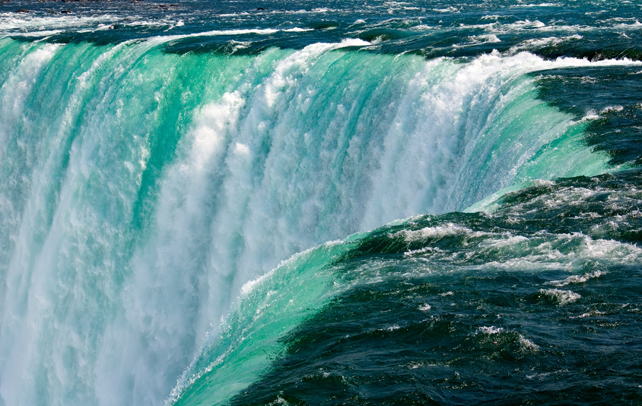Fun Facts About Niagara Falls

The majestic Niagara Falls, spellbinding to look at, are among the most preferred visiting spots in USA and Canada for those who adore the nature’s ferocity. Yet, Niagara Falls, in all their ferocity, spread a mist of calm over their admirers. On this mystic location, stress takes a drop and tranquillity reaches a high. It’s only understandable why hundreds and thousands of visitors flock here, every year, to witness the staggering drop of Niagara River. The striking and verdant green colour of the river too is an evident homage to its own erosive strength. Besides the splendid panoramic view of the falls, several other exciting places of tourist interest—the Niagara Falls State Park, the Rainbow Bridge, the Skylon tower, the Maid of the Mist boat cruise—make for an added bonus.
Fast Facts
Location: Niagara Falls, Ontario, Canada & New York, U.S.A.
Height: 167 ft.
Watercourse: Niagara River
Average Flow Rate: 1,834 m3/s
Number of Drops: 3
Interesting And Fun Facts About Niagara Falls
- Niagara Falls are made of two main divisions: the Canadian Falls, also known as Horseshoe Falls, on the Canadian part and the American Falls on the American region, segmented by Goat Island.
- The Niagara Falls comprise of three different falls: American Falls which are between the Prospect Point and Luna Island; Bridal Veil Falls, between Luna Island and Goat Island; and the Canadian Falls, which are between the Goat Island and Table Rock.
- The Bridal Veil Falls sited on the American region are divided from the main falls by the Luna Island. The global periphery line was actually drawn all the way through Canadian Falls in 1819, but the limit has been under a heated discussion because of construction and natural erosion.
- These falls came into being during the last ice age as a result of glaciers receding at the end of the Wisconsin glaciations about some 10,000 years ago and water coming from the then recently originated Great Lakes, which made a way through the Niagara Escarpment en route to the Atlantic Ocean. These falls are extremely broad with over 168,000 m3 of water falling over the summit line every minute at a high speed and about 110,000 m3 per minute on average.
- The lush green colour of the water flowing from the Niagara Falls is the product of about 60 tonnes/minute dethawed salts and very fine ground rock which are produced by the erosive force of the Niagara River. Besides this, it also perhaps comes from the shales and sandstones which are present under the limestone cap at the Niagara Falls.
- The cities of Niagara Falls—New York and Ontario—are connected by the two international bridges namely the Rainbow Bridge and the Whirlpool Rapids Bridge.
- The Rainbow Bridge, downriver from the Niagara Falls, provides the closest scenic view and is open to non-commercial vehicle traffic and footers. On the other hand, the Whirlpool Rapids Bridge, located 1.6 km north of the Rainbow Bridge is the oldest bridge over the Niagara River.
- Buffalo Niagara International Airport and Niagara Falls International Airport have been named after the Niagara Falls, just like the Niagara University and many local businesses which too have been named after these notable falls.
- Many people have tried to conquer this flowing giant. In October 1829, Sam Patch, jumped from a very high tower into the gorge just below the falls and survived. Thus, it became an enduring tradition of daredevils trying to go over the falls. On 24th October, 1901, 63 year old Annie Edson Taylor, a Michigan school teacher was the first to go over the falls in a barrel; she also survived but was injured.
- The number of visitors to the falls increased rather quickly in 1953, after the release of Niagara, a movie starring the famous Marilyn Monroe and Joseph Cotten. After this, again in 20th century, these falls were a sported site in Superman II (1980) and were also the main subject of a famous IMAX movie, Niagara: Miracles, Myths and Magic.
- In addition to this, the tourist complex near the falls was the background of the short-lived Canadian television show Wonderfalls, which was shot in early 2004. In October 2006, site footage of falls was shot to present ‘World’s End’ of the famous Hollywood movie Pirates of Caribbean: At World’s End.
- The region of Niagara Falls also acted as the base camp for a German aerial invasion of the United States in the novel ‘The War in the Air’, penned by H.G. Wells.
- The most notable and oldest tourist attraction point at Niagara Falls is the ‘Maid of the Mist’ boat cruise, which is named after a prehistoric Ongiara Indian fabled character. Maid of the Mist has been carrying passengers into the torrents, directly below the falls, since 1846. These Cruise boats, each named Maid of the Mist, run from boat decks which are there on both the sides of the Niagara Falls.
- The Upper Steel Arch Bridge, known as the Honeymoon Bridge in old days, was damaged on 27th January 1938 due to the pressure caused from huge ice formation in the gorge below the Niagara Falls.
- The brown foam below the Niagara Falls is a natural outcome of tons of water plunging into the depths below. This brown colour is clay, comprising of suspended particles of decomposed vegetative matter, which mainly comes from the shallow eastern basin of Lake Erie.
- There are many theories related to the origin of the name of Niagara Falls. According to the Iroquoian scholar Bruce Trigger, Niagara has been taken from the name given to a branch of the nearby inhabiting natives of Neutral Confederacy, who are known as the Niagagarega . On the other hand, according to George R. Stewart, it has been originated from the name of an Iroquois province Ongniaahra, which means ‘a point of land cut in two.’









